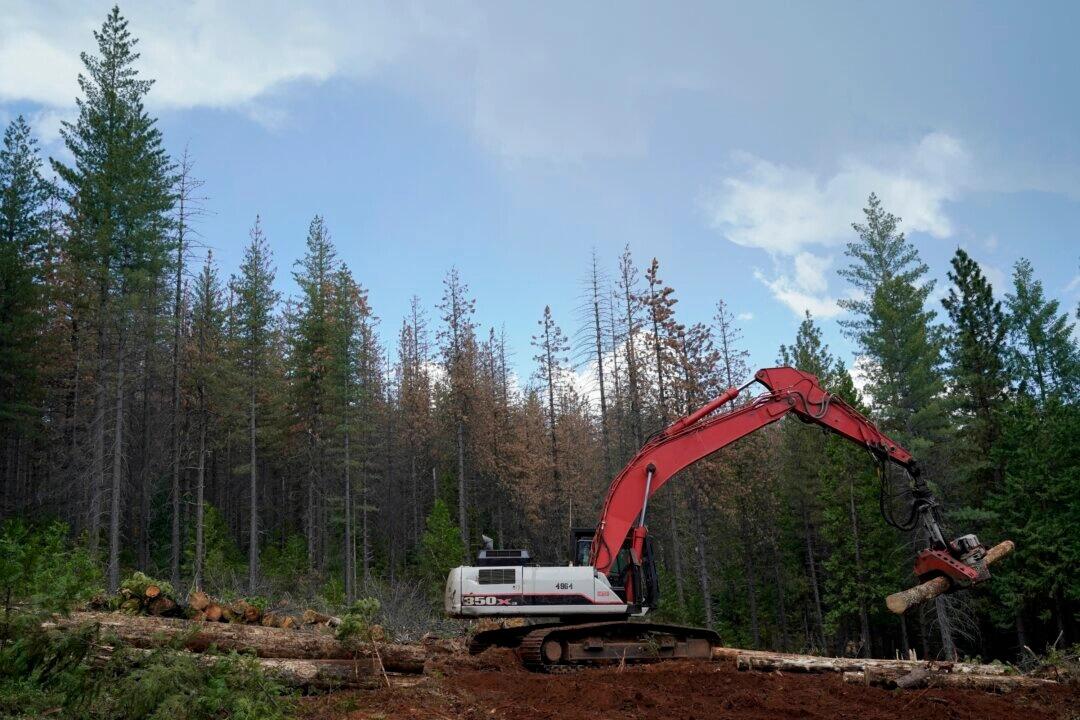USDA Cites Wildfire Risk, Invasive Insects In Orders To Expand Logging In National Forests
Sunday, Apr 06, 2025 - 07:00 PM
Authored by Aldgra Fredly via The Epoch Times (emphasis ours),
The Department of Agriculture (USDA) issued a memo on Friday allowing the use of more than 112 million acres of national forests for logging to increase timber production and reduce wildfire risk.
 A crew member uses a tree processor to strip bark and branches from logs before being transported to a mill near Camptonville, Calif., Tuesday, June 6, 2023. Godofredo A. Vásquez /AP Photo
A crew member uses a tree processor to strip bark and branches from logs before being transported to a mill near Camptonville, Calif., Tuesday, June 6, 2023. Godofredo A. Vásquez /AP PhotoIn the memo dated April 3, USDA Secretary Brooke Rollins declared these forests—making up 59 percent of national forests—to be in an emergency situation due to their high risk of wildfires and hazardous tree conditions. The memo was released on April 4.
Rollins stated that the national forests are in crisis due to “uncharacteristically severe wildfires, insect and disease outbreaks, invasive species, and other stressors.”
Those threats—combined with overgrown forests, the growing number of homes in the wildland-urban interface, and decades of rigorous fire suppression—have contributed to a “full-blown wildfire” and “forest health crisis,” according to the memo.
“Healthy forests require work, and right now, we’re facing a national forest emergency,” Rollins said in a statement. “We have an abundance of timber at high risk of wildfires in our National Forests.”
The emergency designation would allow the Forest Service to expedite approval for logging activity in the designated forests, bypassing the usual processes required under national environmental laws.
The memo directs Forest Service personnel to increase timber production by 25 percent over the next four to five years, while also meeting the minimum requirements of the National Environmental Policy Act and other environmental laws.
In a letter to Forest Service regional foresters, acting associate chief Christopher French said he will direct regulatory authorities to streamline approval processes for timber production in the designated forests.
French called on regional foresters “to the maximum extent practicable, use existing and new categorical exclusions for timber stand improvement, salvage, and other site preparation activities for reforestation, consistent with applicable law.”
Environmental group Earthjustice has rejected the USDA’s emergency designation.
“This absurdly vast, and poorly justified, emergency determination aims to boost logging and reduce environmental safeguards across most national forestlands in a handout to the logging industry,” Earthjustice legislative representative Blaine Miller-McFeeley said in a statement.
Miller-McFeeley said that cutting down trees that currently serve as “important buffers against climate change” will not help to reduce the threat of wildfires, and that it could cause “significant harm” to forest ecosystems and negatively impact the outdoor recreation economy.
The memo follows President Donald Trump’s executive orders aimed at increasing domestic timber and lumber production. The first executive order directed “all affected agencies” to suspend regulations “that impose an undue burden on timber production.” The second directed the commerce secretary to investigate the national security implications of timber imports.
Trump stated that the country’s abundance of timber resources is “more than adequate” to meet domestic needs, but that “heavy-handed Federal policies have prevented full utilization of these resources” and caused it to rely on imported lumber.
“It is vital that we reverse these policies and increase domestic timber production to protect our national and economic security,” Trump stated in his order issued on March 1.
His second order states that the United States’ softwood lumber industry has the practical production capacity to meet 95 percent of its softwood consumption last year. Despite this capacity, the country has been a net importer of lumber since 2016, it stated.
The Forest Service has sold about 3 billion board feet of timber annually for the past decade. Timber sales peaked several decades ago at about 12 billion board feet amid widespread clear-cutting of forests.
Volumes dropped sharply in the 1980s and 1990s as environmental protections were tightened and more areas were put off limits to logging. Most timber is harvested from private lands.
Steven Kovac and The Associated Press contributed to this report.

